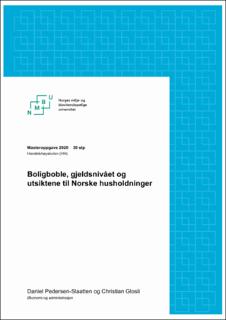| dc.contributor.advisor | Sommervoll, Dag Einar | |
| dc.contributor.author | Glosli, Christian | |
| dc.contributor.author | Pedersen-Slaatten, Daniel | |
| dc.coverage.spatial | Norway | en_US |
| dc.date.accessioned | 2020-10-16T10:28:35Z | |
| dc.date.available | 2020-10-16T10:28:35Z | |
| dc.date.issued | 2020 | |
| dc.identifier.uri | https://hdl.handle.net/11250/2683304 | |
| dc.description.abstract | Denne oppgaven kartlegger om reguleringene som foreligger for opptak av boliglån er tilstrekkelige, sett i lys av stadig boligprisvekst siden 90-tallet. I arbeidet med denne kartleggingen blir det undersøkt om det har påløpt en boligboble som følge av for slapp regulering. Oppgaven kommer frem til at det i tidsintervallet 2014-2018 påløp en boligboble i Oslo, men at effekten ikke har kommet til syne. I dette arbeidet blir det anvendt 3 verktøy som identifiserer boligbobler. Videre legger oppgaven frem om reguleringene tillater husholdningene å ta opp boliglån som ikke er bærekraftig ved nedgangskonjunkturer, eller i situasjoner der rentenivået blir satt kraftig opp. I dette arbeidet er det brukt stresstesting. Denne testen kommer frem til at de fleste husholdningene i utvalget er likvide til tross for ekstreme renteverdier. Siste element i oppgaven er en fremstilling av husholdningers syn på fremtidsutsiktene. Der kommer det frem at husholdningene ikke har tiltro til økonomisk vekst og økte boligpriser i fremtiden. | en_US |
| dc.description.abstract | This paper identifies whether the regulations that are available for house mortgages are adequate, in light of the continued rise in house prices since the 1990s. In the work on this survey, it is investigated whether a housing bubble has arisen as a result of excessive regulation. The thesis concludes that in the time period 2014-2018 a housing bubble occurred in Oslo, but that the effect has not appeared. In this work, 3 tools are used to identify housing bubbles. Furthermore, the thesis states whether the regulations allow households to raise mortgages that are not sustainable in the downturn, or in situations where interest rates are set sharply. Stress testing has been used in this work. This test shows that most households in the sample are liquid, despite extreme interest rates. The final element of the thesis is a presentation of households' views on the future. It appears that households do not have confidence in economic growth and higher house prices in the future. | en_US |
| dc.language.iso | nob | en_US |
| dc.publisher | Norwegian University of Life Sciences, Ås | en_US |
| dc.rights | Attribution-NonCommercial-NoDerivatives 4.0 Internasjonal | * |
| dc.rights.uri | http://creativecommons.org/licenses/by-nc-nd/4.0/deed.no | * |
| dc.title | Boligboble, gjeldsnivået og utsiktene til norske husholdninger | en_US |
| dc.title.alternative | Housing bubbles, debt and the prospects of Norwegian households | en_US |
| dc.type | Master thesis | en_US |
| dc.source.pagenumber | 68 | en_US |
| dc.description.localcode | M-ØA | en_US |

